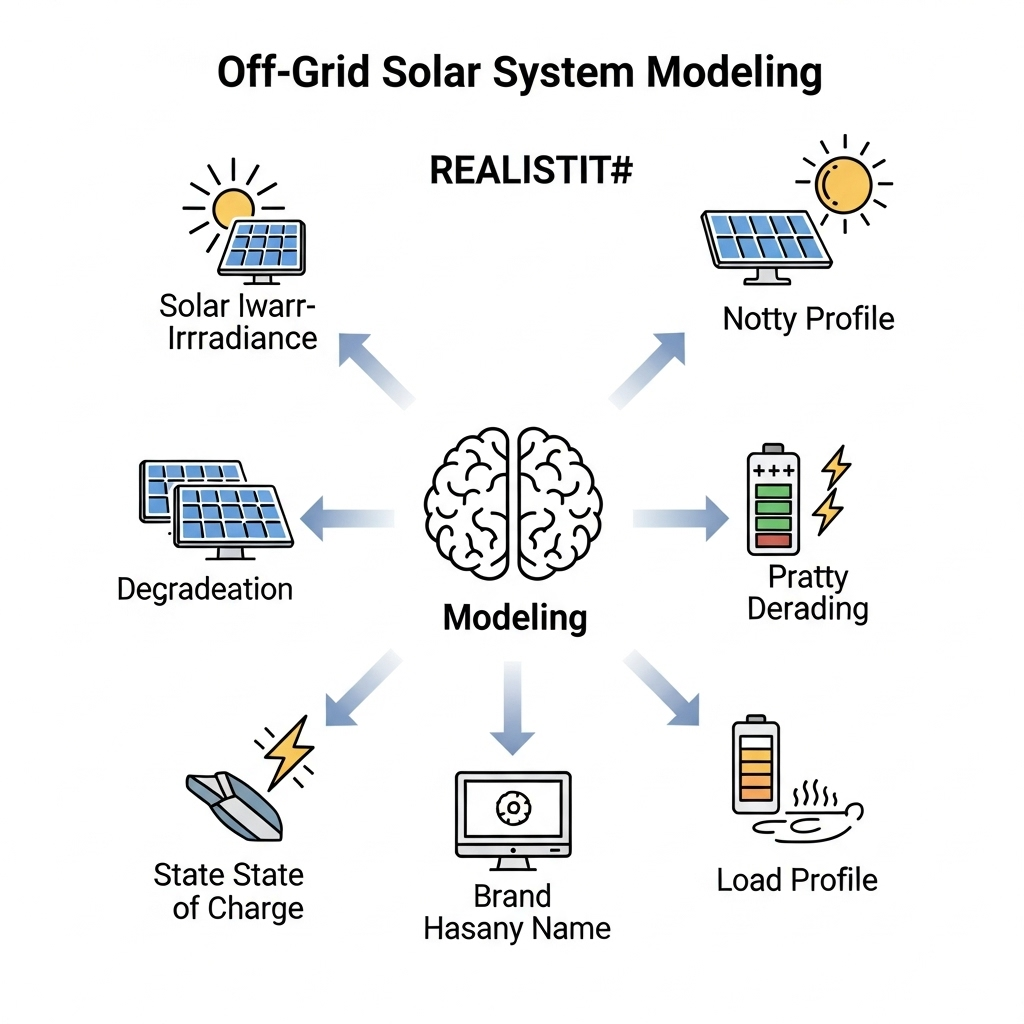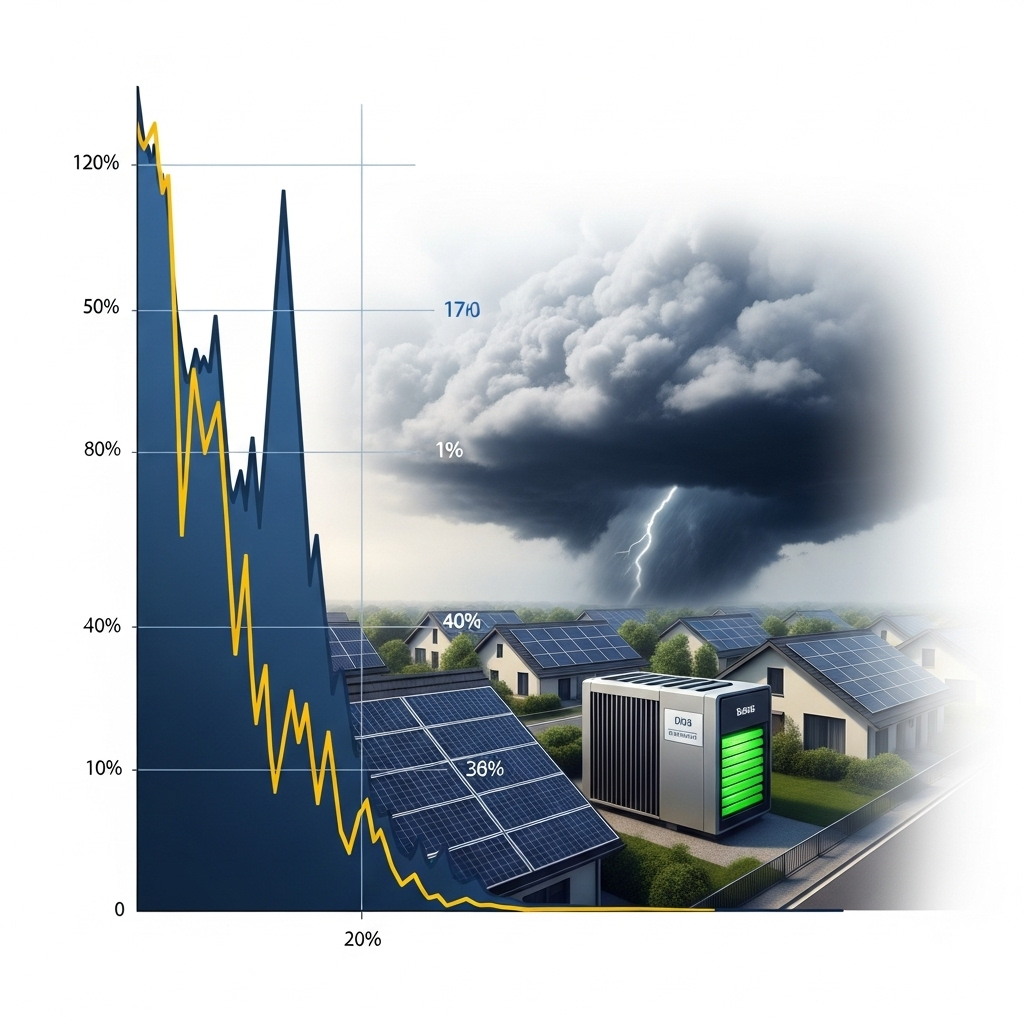Achieving energy independence with an off-grid solar system is a powerful goal. But its success depends entirely on reliability. A system that fails during a string of cloudy days is not a solution. The key to building a resilient system lies in accurately modeling your potential solar energy generation, or PV yield, and accounting for the unpredictability of energy storage. Simple calculations often fall short, leading to undersized systems that disappoint or oversized systems that are unnecessarily expensive. This guide provides a framework for modeling these critical uncertainties, helping you design a system you can truly count on.
Understanding the Core Variables in PV Yield Modeling
Effective PV system modeling goes far beyond a simple calculation of peak sun hours. It requires a detailed look at environmental factors and the physical components of your system. A robust model accounts for the dynamic nature of solar energy production over the long term.
Beyond Peak Sun Hours: Factoring in Irradiance Variability
Peak sun hours provide a baseline, but real-world solar irradiance is much more complex. Your location's weather patterns, including seasonal cloud cover, fog, and even smoke from distant wildfires, can dramatically reduce PV yield. Advanced PV system modeling uses high-resolution meteorological data to create a more accurate picture. According to research from the National Renewable Energy Laboratory, localized impacts like snow cover can significantly affect PV generation. Therefore, your model should incorporate historical weather data specific to your area, not just regional averages, to forecast output more reliably.
Component Performance and Degradation
Your solar components will not perform at their nameplate rating forever. Solar panels, inverters, and wiring all degrade over time. Solar panels have a power tolerance and a temperature coefficient, which dictates how their output drops as they heat up. Over 25 years, a panel's output might degrade by 10-20%. Inverters also have efficiency curves and a finite lifespan. Soiling from dust, pollen, and pollution can create a persistent film that reduces the light reaching the cells. A comprehensive long-term yield forecasting model must account for these gradual losses to provide a realistic expectation of performance in year 5, 10, and 20.
The Role of System Design and Shading
The physical layout of your solar array is fundamental to its output. Panel orientation (azimuth) and tilt angle must be optimized for your latitude to capture the most sunlight throughout the year. Even small amounts of shading from trees, chimneys, or future construction can have a disproportionate impact on the entire array's output. As highlighted in a project supported by the U.S. Department of Energy, tools like Smart Power Maps can be used to model site-specific challenges, including topography and potential obstructions. A thorough site analysis is a non-negotiable first step in any serious modeling effort.
Quantifying and Managing Storage Uncertainty
Your battery bank is the heart of an off-grid system, providing power when the sun isn't shining. However, its capacity and performance are not static. Modeling storage uncertainty is just as important as modeling PV yield.
The Challenge of State of Charge (SoC) Management
Managing your battery's State of Charge (SoC) is a delicate balancing act. It is influenced by fluctuating solar generation and your own variable energy consumption. A few days of low solar input combined with high usage can quickly deplete your reserves. The International Energy Agency (IEA) notes that as renewable energy contributions increase, managing variability becomes a primary challenge. In its report, Getting Wind and Solar onto the Grid, the IEA discusses how forecasting over several days is needed for careful management of storage. This is where high-quality batteries, such as Lithium Iron Phosphate (LiFePO4), offer an advantage with their ability to handle deep discharges without significant damage, providing a greater usable capacity and a buffer against uncertainty.
Modeling Battery Degradation and Capacity Fade
A battery's nameplate capacity is what it can store when new. Over time, this capacity fades due to charge-discharge cycles, age, and operating temperature. This degradation is a critical variable in long-term modeling. For example, a LiFePO4 battery might be rated for 6,000 cycles at an 80% depth of discharge (DoD), but its performance will differ at 100% DoD or in extreme temperatures. As detailed in this ultimate reference on solar storage performance, factors like C-rate and DoD directly impact a battery's lifespan. Your storage model should incorporate the manufacturer's data sheets to project capacity fade over the system's intended life, ensuring it will still meet your needs years down the line.
Accounting for Load Profile Variability
Your energy usage is not a flat line. It has daily peaks, like when you run a well pump or an appliance, and seasonal shifts, such as increased lighting and heating in the winter. Failing to accurately model your load profile is a common reason off-grid systems fail. You should analyze your consumption patterns and build a model that reflects these variations. A system sized for your average load will fail during peak load. A robust model simulates these high-demand scenarios against periods of low solar generation to ensure your battery storage is sufficient to bridge the gap.
Practical Modeling Approaches and Tools
With an understanding of the variables, you can begin to apply practical modeling techniques. These range from simple spreadsheets to sophisticated software, but the goal is the same: to replace assumptions with data-driven projections.
Probabilistic vs. Deterministic Forecasting
A deterministic model provides a single, specific outcome (e.g., 'the system will generate 15 kWh tomorrow'). This approach is simple but brittle, as it ignores the element of chance. A probabilistic model, in contrast, provides a range of possible outcomes and their likelihoods (e.g., 'there is a 90% probability of generating at least 12 kWh'). For an off-grid system where reliability is paramount, probabilistic forecasting is superior. It allows you to design for a desired level of confidence, for instance, ensuring your system can meet your needs 99% of the time, even in poor weather.
Building a Simple Simulation Model
You can create a basic simulation in a spreadsheet to visualize your system's energy balance. By inputting daily solar yield estimates (from a source like PVWatts) and your expected load profile, you can track the battery's SoC over a year. This exercise quickly reveals how a sequence of low-sun days can impact your energy security.
| Day | Projected Solar Generation (kWh) | Projected Load (kWh) | Battery SoC (Start of Day) | Battery SoC (End of Day) |
|---|---|---|---|---|
| 1 (Sunny) | 18.0 | 10.0 | 80% | 100% |
| 2 (Sunny) | 17.5 | 10.0 | 100% | 100% |
| 3 (Cloudy) | 6.0 | 11.0 | 100% | 75% |
| 4 (Cloudy) | 5.5 | 11.0 | 75% | 47.5% |
| 5 (Stormy) | 2.0 | 12.0 | 47.5% | -2.5% (System Failure) |
This simplified table illustrates how quickly a surplus can turn into a deficit. A real model would use more granular data and account for battery efficiency losses.
Leveraging Advanced Modeling Frameworks
For critical applications, professional modeling software is invaluable. These tools integrate vast historical weather datasets, detailed component specifications, and complex degradation algorithms. They can run thousands of simulations to stress-test a design against worst-case scenarios. The International Renewable Energy Agency's Electricity Storage Valuation Framework emphasizes that such tools are necessary to properly assess the value and viability of an energy storage project. While you may not need this level of analysis for a small cabin, the principles of using comprehensive data to ensure project viability apply to any off-grid system.
From Model to Reality: Ensuring Long-Term Reliability
Modeling PV yield and storage uncertainty is not just a theoretical exercise; it is the foundation of a dependable off-grid energy system. An accurate model informs every decision, from selecting the right LiFePO4 battery capacity to determining the optimal number of solar panels. It transforms your plan from a hopeful guess into a calculated strategy for energy independence. By embracing a data-driven approach, you build a system that is resilient to weather variability, component aging, and the demands of your unique lifestyle, securing reliable power for years to come.
Frequently Asked Questions
What is the biggest mistake people make when modeling PV yield?
The most common mistake is relying on overly optimistic 'best-case scenario' numbers. This often involves using only peak sun hour data without accounting for real-world losses from weather, shading, soiling, and component degradation. A reliable model must be conservative and based on historical data for your specific location.
How often should I update my off-grid system model?
You should review your model if your circumstances change significantly. This could include adding major new appliances (increasing your load), noticing a decline in system performance, or if nearby construction or tree growth creates new shading issues. A quick annual check of your assumptions against actual performance is also a good practice.
Can I model my system without expensive software?
Yes, you can create a very useful model using a spreadsheet. By using publicly available data from tools like the NREL's PVWatts calculator, your own load estimates, and battery manufacturer specifications, you can build a day-by-day energy balance sheet for an entire year. While not as sophisticated as professional software, it is far better than no model at all.
How does battery chemistry, like LiFePO4, affect storage uncertainty modeling?
Battery chemistry is a major factor. LiFePO4 batteries have a very flat voltage curve, making SoC harder to estimate from voltage alone compared to lead-acid batteries. However, they excel in other areas critical to modeling: they have a much higher cycle life, degrade more slowly, and can be safely discharged more deeply. This makes them more predictable over the long term. Your model should use the specific performance data (cycle life vs. depth of discharge, efficiency ratings) for the chemistry you choose.





Leave a comment
All comments are moderated before being published.
This site is protected by hCaptcha and the hCaptcha Privacy Policy and Terms of Service apply.